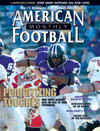AMERICAN FOOTBALL MONTHLY THE #1 RESOURCE FOR FOOTBALL COACHES
Article CategoriesAFM Magazine
|
Winning with Arkansas\' Wildcat Formation: Going to Your Best Athleteby: Mike Kuchar© More from this issue When All-SEC running back Darren McFadden lined up in a shotgun formation directly behind the center in the 2006 SEC Championship Game, the entire Florida defense was surprised, as were the 73,000 fans in attendance at the Georgia Dome. Catching the Gator defense by surprise, McFadden took the snap and connected on a two yard strike with Felix Jones, who was left uncovered in the left flank, cutting the deficit to 17-14. Although the score wasn’t enough to keep the Razorbacks in the game, it was the high point of the 'Wildcat' offense, a system established to showcase the talents of an excellent athlete and take advantage of defenses that couldn’t adjust to the new uncanny scheme. THE CONCEPT Truth be told, Arkansas had been using the Wildcat package in numerous key situations throughout the season. In fact....The full article can only be seen by subscribers. Subscribe today!
|
|
|||||||
| HOME |
MAGAZINE |
SUBSCRIBE | ONLINE COLUMNISTS | COACHING VIDEOS |
Copyright 2025, AmericanFootballMonthly.com
All Rights Reserved





